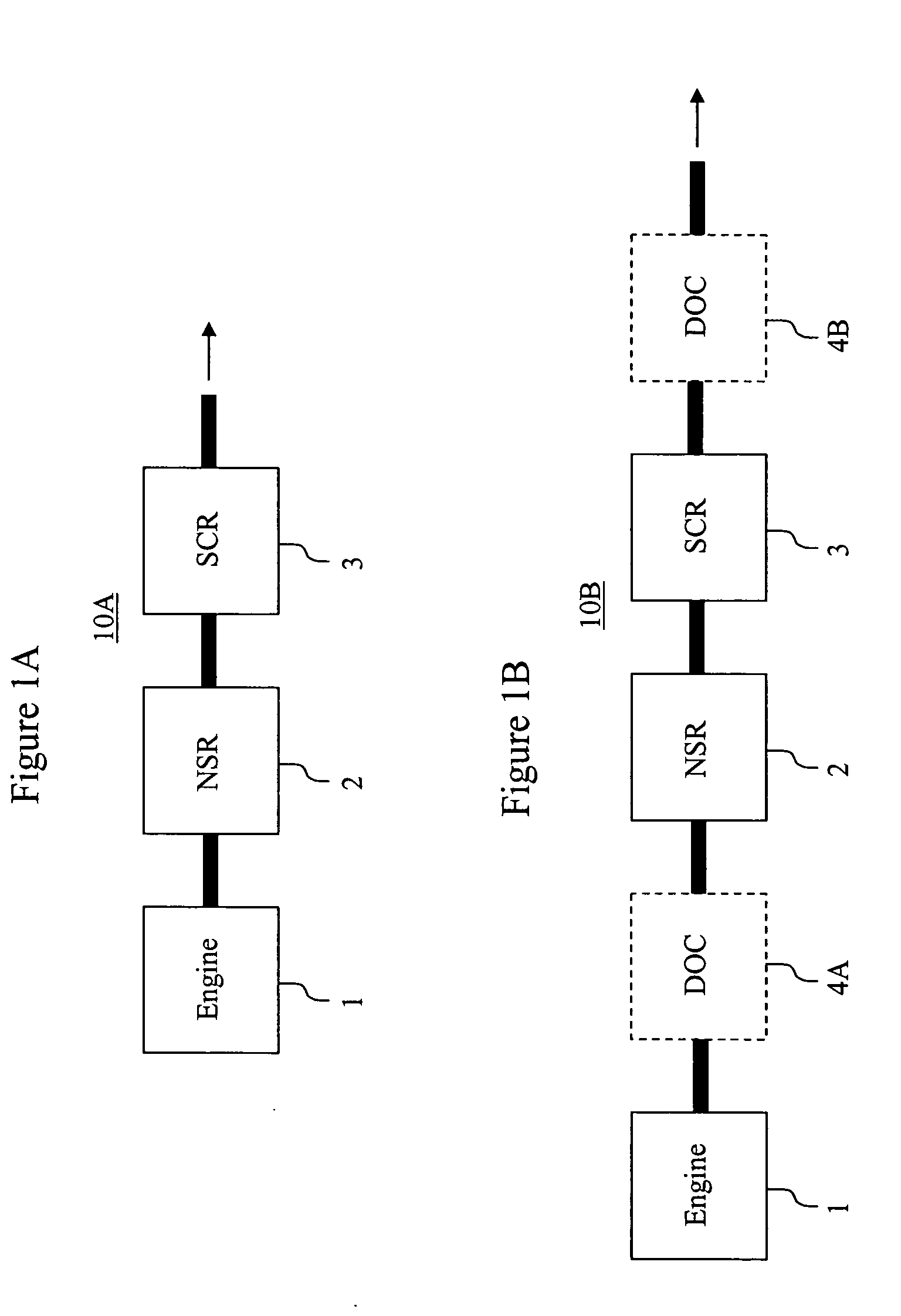Emissions treatment system with NSR and SCR catalysts
a technology of emissions treatment system and catalyst, which is applied in the direction of machines/engines, mechanical equipment, separation processes, etc., can solve the problems of nox species reduction, difficult to achieve effective abatement of nox from lean burn engines, and large etc., to achieve the effect of reducing the size and amount of particulate matter
- Summary
- Abstract
- Description
- Claims
- Application Information
AI Technical Summary
Benefits of technology
Problems solved by technology
Method used
Image
Examples
example 1
Preparation of Catalyst Substrates (NSR Catalysts)
[0105] Catalyst A
[0106] The substrate consisted of cordierite. The bottom layer consisted of 75 g / ft3 platinum, 0.42 g / in3 BaO, 0.05 g / in3 ZrO2 and 1.83 g / in3 of a support consisting of CeO2-coated Al2O3. This support was prepared by the incipient wetness technique to allow 10 wt. % of CeO2 on the surface of the Al2O3. The support material was impregnated with amine solubilized platinum hydroxide to achieve the desired loading. The powder was then milled, in the presence of water, such that 90% of the particles had a particle size below 10 micrometers (i.e., d90<10μ), thereby resulting in a high-solids slurry. During the milling process, barium acetate and zirconyl acetate dissolved in water were also added during the milling process.
[0107] The slurry of the bottom layer was then wash-coated on the cordierite substrate and the coated substrate was then dried at 110° C. for about one hour. Thereafter, the dried coated substrate was...
example 2
Performance Testing for Emissions Treatment Systems Having Catalyst A as an NSR Catalyst, Performance as a Function of CO Concentration in a Rich Feed
[0117] In this example, the NOx conversion, NH3 and N2 formation were determined as a function of the CO concentration in the rich pulse (i.e., in the rich gaseous stream). These determinations were first conducted with a system having in serial arrangement Catalyst A as the upstream substrate and a blank flow through monolith substrate as the downstream substrate. This system is referred to herein as “System I.”
[0118] A second system that was evaluated had in a serial arrangement, Catalyst A as the upstream substrate and SCR Catalyst D as the downstream substrate, which is referred to herein as “System II.” SCR catalyst D contained a catalyst composition with 1.8 g / in3 iron exchanged Beta zeolite with 4 wt. % ZrO2 binder that was coated onto a flow through monolith substrate.
[0119] Performance tests were conducted with an alternatin...
example 3
Performance Testing for Emissions Treatment Systems Having Catalyst A as an NSR Catalyst; Performance as a Function of Rich Feed Timing
[0121] In this example, the NOx conversion, NH3 and N2 formation were determined as a function of the rich feed timing. These determinations were first conducted with both System I and System II. System I and II are described in Example 2.
[0122] Performance tests were conducted with an alternating lean and rich feed. The lean feed consisted of 10% O2, 10% H2O, 5% CO2 and 200 ppm NO. The rich feed consisted of 0.8% HC (as C3H6), 1% O2, 10% H2O, 5% CO2, 200 ppm NO and 4% CO. The systems were evaluated at temperatures of 200, 250, 300, 350 and 450° C. with a GHSV of 60,000 h−1. In this test, the length of the rich pulse (rich period) was 1, 3 or 5 seconds while the lean period was always 50 seconds. Once the performance stabilized at a given temperature, data were collected for a period of 10 minutes. NO and NO2 concentrations (and therefore NOx conce...
PUM
| Property | Measurement | Unit |
|---|---|---|
| Temperature | aaaaa | aaaaa |
| Fraction | aaaaa | aaaaa |
| Concentration | aaaaa | aaaaa |
Abstract
Description
Claims
Application Information
 Login to View More
Login to View More - R&D
- Intellectual Property
- Life Sciences
- Materials
- Tech Scout
- Unparalleled Data Quality
- Higher Quality Content
- 60% Fewer Hallucinations
Browse by: Latest US Patents, China's latest patents, Technical Efficacy Thesaurus, Application Domain, Technology Topic, Popular Technical Reports.
© 2025 PatSnap. All rights reserved.Legal|Privacy policy|Modern Slavery Act Transparency Statement|Sitemap|About US| Contact US: help@patsnap.com



